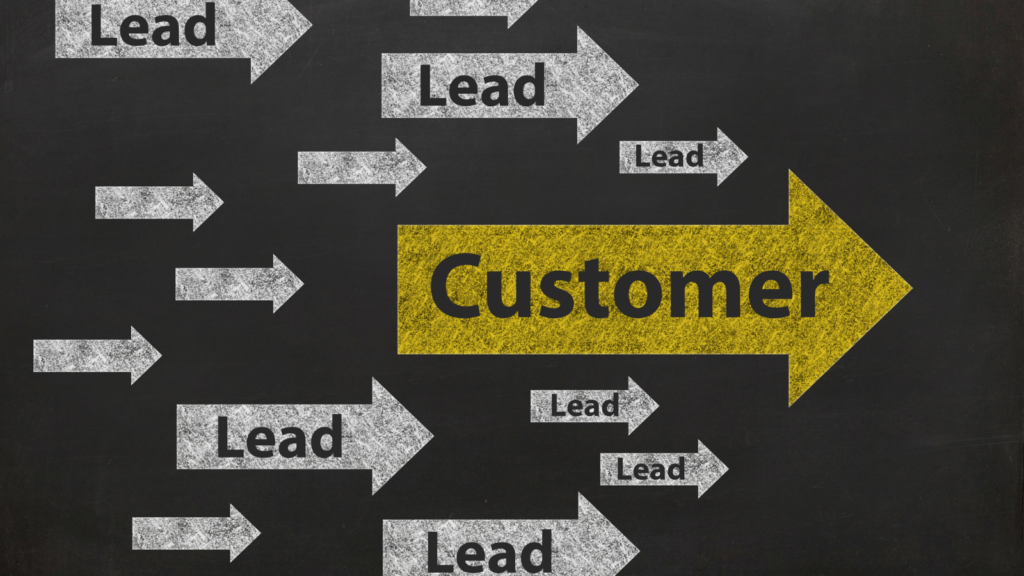In today’s highly competitive market, small businesses face numerous challenges, but perhaps none are as critical as the need for consistent lead generation.
Here, we explore why establishing a robust lead generation system is more than a growth strategy—it’s a survival tactic.
Without a formal system in place, businesses risk everything from unstable cash flow to total dependency on a limited number of clients, which can stifle growth and increase vulnerability to market fluctuations.
This article explores the significant risks associated with neglecting lead generation and provides actionable insights on how to build a system that effectively attracts and nurtures potential leads.
From understanding the peril of inconsistent lead flow to harnessing the power of data-driven strategies, we will cover essential aspects that underscore the importance of this crucial business function.
Whether you’re looking to refine your existing approach or starting from scratch, the insights offered here will equip you with the knowledge to position your business for sustained growth and competitive advantage.

#1 The Perils of Inconsistent Lead Flow and Financial Instability
In small business operations, consistent lead generation is not just a growth lever but a cornerstone of financial stability.
Without a steady stream of new leads, businesses face unpredictable revenue cycles that can complicate budgeting, impede cash flow management, and ultimately threaten their financial health.
Here’s a closer look at how inconsistent lead generation can create significant risks for small businesses and why establishing a regular flow is vital.
Unpredictable Revenue Cycles
A business that lacks a consistent lead generation system often grapples with fluctuating sales volumes, making it difficult to predict revenues from one quarter to the next. This unpredictability complicates everything from inventory management to staffing decisions and can lead to strategic missteps.
For instance, a business might scale up operations during a temporary peak only to find itself overstaffed and overstocked when demand abruptly declines.
Compounded Cash Flow Issues
Cash flow is the lifeline of any small business. Inconsistent leads directly translate into inconsistent sales, which in turn affects cash flow. Regular, predictable cash flow is essential for covering operating expenses and, planning growth investments and securing financing.
Banks and investors are more likely to support businesses that can demonstrate steady financial performance, which stems from a stable lead generation and conversion process.
Planning and Budgeting Challenges
Effective financial planning and budgeting depend on accurately forecasting future revenues. Inconsistencies in lead generation make these forecasts less reliable, which can lead to missed opportunities or unwise spending.
For example, a business might hesitate to invest in a promising growth opportunity due to fears of a revenue shortfall, or conversely, it may overextend financially during a period of unexpectedly high leads.
The Ripple Effect on Business Decisions
The effects of erratic lead generation extend beyond financial metrics; they also impact strategic decisions. Without a clear view of future leads and revenues, making informed decisions about investments, new hires, marketing strategies, and expansion plans is challenging.
This uncertainty can cause businesses to either take excessive risks or miss out on growth opportunities due to excessive caution.
Establishing a Steady Lead Flow
To mitigate these risks, small businesses must focus on building and maintaining a robust lead generation system. This involves more than just promotional activities; it includes refining target market analyses, enhancing engagement strategies, and continuously adjusting tactics based on market feedback and performance metrics.
By establishing a more predictable lead generation process, businesses can stabilise their revenue streams, improve financial planning, and make more confident strategic decisions, laying a foundation for sustainable growth and success.
#2 High Dependency on Few Clients: A Risky Business Model
Relying on a small number of clients for the bulk of your revenue is a common scenario in many small businesses, especially those in the early stages of development.
While this might seem manageable initially, over-reliance on a limited client base exposes your business to significant risks should the spending habits of these few clients change.
Here’s how a lack of diverse lead sources can threaten your business stability and what you can do to mitigate these risks.
Increased Vulnerability
A business that depends heavily on a handful of clients is vulnerable to sudden changes in their clients’ business health or buying decisions. If even one major client faces financial difficulties, discontinues their relationship, or simply decides to diversify their own supplier base, it can leave a significant revenue gap.
This vulnerability can lead to financial instability and jeopardise the business’s long-term viability.
Scaling Challenges
Businesses focusing too narrowly on serving a small client base often struggle to scale effectively. Growth requires reaching out to new market segments and expanding the client portfolio.
Without a broad lead generation strategy, scaling becomes a strategic challenge, limiting the business’s potential to expand its market reach and revenue sources.
Strategic Rigidity
Over-dependence on specific clients can lead to strategic rigidity, where a business becomes too aligned with the demands and needs of a few rather than considering broader market opportunities.
This can stifle innovation and prevent the business from adapting to new market trends or exploring different customer segments.
Diversifying Your Client Base
To avoid the pitfalls of client concentration, it’s crucial to diversify your lead sources.
This involves:
Expanding Marketing Channels: Utilize a mix of digital and traditional marketing channels to reach a broader audience. SEO, content marketing, social media, and even offline events can attract different types of clients.
Refining Your Offerings: Regularly update and adapt your products or services to appeal to various customer needs and preferences, which can attract a wider clientele.
Building Strong Relationships: While attracting new clients, also focus on building deeper relationships with existing clients without becoming overly dependent on them. This balances maintaining valuable ties and mitigating risks associated with client concentration.
By expanding your lead generation efforts and diversifying your client base, you reduce the risks associated with client concentration and set a solid foundation for sustainable growth and stability.
This approach ensures financial health and enhances your business’s resilience against market fluctuations.
#3 Navigating Growth Challenges Without Steady New Leads
The journey to expand a small business is fraught with challenges, but few are as critical as maintaining a consistent inflow of new leads.
Growth isn’t just about increasing sales with existing customers—it’s about continuously attracting new customers to widen the business base and increase market share.
Here’s why steady new leads are essential for sustainable business growth and how their absence can stifle your expansion efforts.
Stunting Revenue Growth
Without a consistent stream of new leads, revenue growth can plateau. Existing customers may provide repeat business, but their contribution to revenue will eventually reach a limit.
New leads are crucial for injecting fresh revenue into the business, helping to overcome the natural attrition of customer bases and the cyclical downturns in purchasing.
Limiting Market Expansion
A lack of new leads means missing opportunities to expand into new markets or demographics. Understanding and tapping into diverse customer segments is vital for a business looking to grow.
New leads provide the data and insights to tailor marketing strategies and product offerings to new audiences, fostering expansion and diversification.
Inhibiting Competitive Edge
In competitive markets, the ability to continuously generate new leads can be what sets a business apart from its competitors. Businesses that fail to innovate in lead generation may find themselves outpaced by competitors who are more adept at attracting new customers.
Without fresh leads, a business risks losing its relevance and momentum in the market.
Strategies to Boost New Lead Acquisition
To ensure a steady flow of new leads and support business growth, consider these actionable strategies:
Enhanced Digital Presence: Invest in SEO, PPC advertising, and social media to increase your online visibility. A strong digital presence helps capture the attention of potential new customers searching for solutions your business offers.
Networking and Partnerships: Leverage networking events, industry conferences, and partnerships to reach new audiences. These channels can provide valuable leads that might not be accessible through digital marketing alone.
Customer Referral Programs: Encourage existing customers to refer new clients. Referral programs can be a cost-effective way to generate high-quality leads, as they come with a pre-established level of trust based on the referrer’s positive experience.
Regular Market Research: Conduct market research to stay ahead of industry trends and customer preferences. Understanding what drives potential customers allows you to refine your offerings and marketing messages to meet the needs of new market segments better.
By implementing these strategies, your business can maintain a robust pipeline of new leads, which is crucial for navigating growth challenges and ensuring long-term success.
Each new lead represents an immediate sales opportunity, a step towards broader market penetration, and enhanced competitive strength.

#4 Staying Competitive: The Role of Systematic Lead Generation
In the dynamic landscape of small business, staying competitive often hinges on your ability to generate new leads consistently. A systematic approach to lead generation helps maintain a steady stream of potential customers and ensures that your business remains relevant and responsive to changing market demands.
Here’s how systematic lead generation contributes to maintaining a competitive edge and the potential consequences of neglecting this crucial activity.
Continuous Market Relevance
Regular lead generation activities force a business to continuously evaluate and respond to its target market’s evolving needs and behaviours.
This ongoing engagement with market trends helps a business stay aligned with customer expectations and technological advancements, ensuring that the offerings remain relevant and desirable.
Enhanced Brand Awareness
Systematic lead generation increases your brand’s visibility across various platforms and touchpoints.
This consistent presence keeps your business top of mind for potential customers and gradually builds a reputation as a reliable and authoritative figure in your industry. Increased brand awareness directly contributes to competitive advantage, as customers are more likely to choose brands they recognise and trust.
Leveraging Technological Innovations
Adopting new technologies for lead generation—such as automation tools, advanced CRM systems, and data analytics—can significantly enhance the efficiency and effectiveness of your marketing efforts.
Businesses that leverage these tools can often outperform their less tech-savvy competitors by targeting customers at the right time with the right messages.
Implementing a Systematic Lead Generation Strategy
To harness the full potential of systematic lead generation, consider the following strategies:
Integrated Marketing Campaigns: Develop integrated marketing campaigns that utilize multiple channels (online and offline) to reach potential customers. This could include social media marketing, email campaigns, content marketing, and traditional advertising. Each channel should reinforce the other, creating a cohesive message and brand experience.
Data-Driven Decision-Making: Utilize data from past marketing campaigns and customer interactions to refine and optimise future lead-generation efforts. Analysing data can reveal insights into the most effective tactics, which demographics are responding to, and how to improve conversion rates.
Continuous Learning and Adaptation: The market is always changing, and so should your lead generation strategies. Update your tactics regularly based on the latest market research, competitor analysis, and customer feedback.
This adaptability ensures your methods remain effective and your business stays competitive.
By adopting a systematic approach to lead generation, your business will sustain its market position and set the stage for growth and innovation.
This proactive stance is crucial in today’s fast-paced business environment, where staying competitive means staying ahead of customer needs and industry trends.
#5 Data-Driven Strategies: Key to Effective Lead Generation
In the digital age, leveraging data is not just an advantage; it’s necessary for small businesses aiming to optimise their lead generation efforts.
Data-driven strategies enable precise targeting, enhance campaign performance, and lead to more effective resource allocation.
Here’s why embracing a data-centric approach is crucial for your lead generation strategy and how it can transform your marketing efforts.
Precision in Targeting
Data allows businesses to identify and focus on their most profitable customer segments. By analysing behaviours, preferences, and past interactions, businesses can tailor their marketing messages to resonate deeply with their target audience.
This targeted approach increases your campaigns’ effectiveness and reduces waste by minimising efforts spent on less likely prospects.
Measuring and Enhancing Campaign Performance
Data provides the metrics needed to evaluate the success of lead-generation campaigns. Key performance indicators (KPIs) such as conversion rates, click-through rates, and cost per lead give valuable insights into what’s working and what isn’t.
This continuous feedback loop enables businesses to refine their strategies in real-time, enhancing overall campaign performance and ROI.
Optimising Budget Allocation
With clear data on the performance of various marketing channels and tactics, businesses can make informed decisions about where to allocate their budget.
Investing more in high-performing channels and cutting back on those that do not yield desired results ensures that every dollar spent contributes positively to lead generation efforts.
Implementing Data-Driven Lead Generation
To effectively integrate data-driven strategies into your lead generation plan, consider the following steps:
Invest in the Right Tools: Utilize marketing automation software, CRM systems, and analytics platforms that can gather and process large amounts of data. These tools provide the foundation for any data-driven marketing strategy.
Set Clear Objectives and Metrics: Define success for your lead generation efforts and establish clear metrics to measure it. These might include the number of leads generated, the quality of leads, or the cost-effectiveness of acquisition channels.
Conduct A/B Testing: Regularly test different aspects of your marketing campaigns, from email subject lines to landing page designs. A/B testing helps identify the most effective elements of your strategy, which can then be optimised for better performance.
Train Your Team: Ensure your marketing team has the skills to interpret data and apply insights. Regular training and development sessions can keep your team up to speed with the latest data analysis techniques and tools.
Adopting a data-driven approach will enhance your lead-generation capabilities and set a foundation for more strategic and informed decision-making across all marketing efforts.
This shift towards data-centric strategies is crucial for staying competitive in today’s fast-paced market environment.
#6 Lead Nurturing: Turning Prospects into Profits
Effective lead generation is only the first step; the real challenge—and opportunity—lies in nurturing those leads to convert them into loyal customers.
Lead nurturing is a critical process that builds relationships with potential buyers at every sales funnel stage.
Here’s how lead nurturing can significantly enhance your conversion rates and the strategies you can employ to make the most of your leads.
Building Relationships Over Time
Lead nurturing is about fostering relationships with potential customers over time. It involves understanding the needs and timelines of your leads and providing them with the information and support they need at each step of their decision-making process.
This gradual engagement helps build trust and credibility, which is crucial for converting leads into sales.
Increasing Conversion Rates
A well-implemented lead nurturing strategy can lead to higher conversion rates.
Prospects who are nurtured with targeted content demonstrate a higher readiness to purchase compared to those who are not nurtured.
This is because nurtured leads have a deeper understanding of the product or service offered and feel a greater affinity with the brand.
Reducing Sales Cycles
Effective lead nurturing can also shorten the sales cycle. Businesses can accelerate decision-making by maintaining constant communication and increasing the leads’ engagement and knowledge about the offerings.
This not only speeds up sales but also improves the efficiency of the sales process.
Key Strategies for Successful Lead Nurturing
To harness the full potential of lead nurturing, consider implementing the following strategies:
Personalised Communication: Use the data you’ve collected on your leads to tailor communications to their specific needs and interests. Personalisation can significantly increase the relevance and effectiveness of your messages.
Educational Content: Provide valuable content that educates your leads about your industry, solutions, or other relevant topics. This can include blog posts, ebooks, webinars, and newsletters.
Regular Follow-ups: Keep in touch with your leads regularly, but ensure each interaction adds value. Avoid over-contacting, which can lead to lead fatigue.
Segment Your Leads: Divide your leads based on their behaviours, demographics, and where they are in the buying process. This allows for more targeted and effective nurturing strategies.
Leverage Automation Tools: Utilize marketing automation tools to schedule and deliver content at optimal times. These tools can help manage large volumes of leads efficiently, ensuring no one slips through the cracks.
Focusing on these lead nurturing strategies can turn warm leads into sales and foster long-term relationships that benefit both the customer and your business.
Effective lead nurturing improves conversions and enhances the overall customer experience, leading to greater brand loyalty and retention.

#7 Diversifying Lead Sources to Safeguard Your Business
Diversification is a key principle not only in investment but also in lead generation.
Relying on a single source of leads can leave your business vulnerable to sudden market changes or platform-specific updates.
By diversifying your lead sources, you ensure a more stable and resilient approach to building your customer base.
Here’s how diversifying your lead generation strategies can protect and enhance your business’s growth.
Reducing Dependency on a Single Channel
Many businesses fall into the trap of focusing on one lead source—often the one that initially offers the most promising results.
However, changes in algorithm policies, platform popularity, or audience behaviour can dramatically affect the effectiveness of a single channel.
Diversifying your lead sources ensures that you are not overly dependent on any one channel, which can help mitigate these risks.
Expanding Market Reach
Different lead sources tap into different segments of the market. By diversifying, you open your business to wider audiences, increasing the potential customer base.
This expansion allows you to explore new markets, test different approaches, and identify the most effective ways to reach various customer groups.
Enhancing Lead Quality
Different sources often provide leads at different stages of readiness. Some channels might bring in leads in the early stages of information gathering, while others might attract leads ready to purchase.
By diversifying, you can manage a balanced lead portfolio and optimize your conversion strategies to suit various lead types.
Strategies for Diversifying Lead Sources
To effectively diversify your lead generation sources, consider the following strategies:
Leverage Multiple Digital Platforms: Utilize a combination of SEO, pay-per-click (PPC) advertising, social media, and content marketing to generate leads. Each platform offers unique advantages and reaches different audiences.
Explore Offline Opportunities: Don’t overlook offline sources such as networking events, trade shows, and referrals. These can provide valuable leads and add a personal touch that digital interactions sometimes lack.
Partner with Other Businesses: Form partnerships with businesses that offer complementary services. This can open up new lead channels and provide mutual benefits to both parties.
Regularly Test and Evaluate Sources: Continuously evaluate the effectiveness of different lead sources. Track performance metrics for each source and adjust your strategy based on the results.
Innovate with New Tactics: Stay updated with emerging marketing trends and technologies. Experiment with new tactics, such as influencer partnerships or interactive content, to attract leads from new avenues.
By broadening your lead generation efforts across multiple channels, you protect your business from fluctuations in any single source and set the stage for sustained growth and market expansion.
Diversifying lead sources is essential for building a robust marketing strategy that adapts to changing market conditions and customer preferences.
#8 The Impact of Ignoring Lead Engagement on Acquisition Costs
Engagement with potential leads is not just a nurturing tool—it’s a crucial strategy for reducing the overall cost of customer acquisition. Ignoring lead engagement can lead to higher marketing expenses and lower conversion rates, making it more costly to acquire each customer.
Understanding the impact of engagement on lead conversion and acquisition costs is essential for any business looking to optimise its marketing spend.
Here’s how neglecting lead engagement can inflate costs and what you can do to prevent this.
Higher Marketing Spend with Lower Returns
When leads are not actively engaged, they are more likely to lose interest in your offerings. This disinterest means businesses have to spend more on marketing efforts to recapture attention or reach new leads, all while the effectiveness of these efforts diminishes.
The cycle of disengagement and increased spending without corresponding returns can quickly escalate marketing costs.
Increased Lead Attrition
Leads that are not engaged tend to drop off or choose competitors who maintain better communication. This attrition requires constant replenishment of the lead pool, which is often more expensive than retaining existing leads through engagement.
The cost of acquiring a new customer is much higher than keeping an existing one engaged.
Longer Sales Cycles
A lack of engagement can prolong the sales cycle. Leads without regular contact or follow-up may take longer to make a buying decision, requiring more resources and time to convert them into customers.
These extended cycles strain resources and can delay the realisation of revenue.
Enhancing Lead Engagement to Lower Costs
To mitigate the impact of ignored lead engagement on acquisition costs, consider implementing these strategic actions:
Consistent Communication: Establish a regular communication schedule with leads using various channels, such as email, social media, and personalized outreach. Consistent, valuable communication keeps leads warm and reduces the likelihood of disengagement.
Engagement Analytics: Use tools to track engagement levels, such as email open rates, click-through rates, and interaction times on your website. These metrics can help identify areas of low engagement and allow for targeted improvements.
Interactive Content: Deploy interactive content such as quizzes, polls, webinars, and videos to keep leads engaged. These tools maintain interest and provide additional insights into lead preferences and behaviours.
Feedback Mechanisms: Incorporate feedback channels into your engagement strategy. Allowing leads to voice their needs or concerns can foster a stronger connection and provide valuable data to refine your approach.
Personalisation: Use data gathered from lead interactions to personalise the content, offers, and messages. Personalisation increases relevance and engagement, making leads feel valued and understood.
By prioritising lead engagement, you can significantly reduce the costs associated with acquiring new customers and enhance the efficiency of your marketing efforts.
Engaged leads are more likely to convert, do so quicker, and cost less in terms of time and resources, making engagement a critical factor in the economics of lead management.

#9 Innovating Lead Generation Tactics for Long-term Success
In the fast-evolving world of marketing, sticking to traditional lead-generation tactics can cause your business to fall behind.
Innovation in lead generation is essential to keep pace with changing consumer behaviours and technological advancements and sustain long-term success and growth.
Here’s why innovating your lead generation tactics is crucial and how it can give you a competitive edge.
Staying Ahead of Consumer Trends
Consumer preferences and behaviours change rapidly, influenced by new technologies, cultural shifts, and economic factors. Businesses that continuously innovate their lead-generation tactics are better positioned to adapt to these changes.
This proactive approach ensures that your marketing strategies remain relevant and effective, appealing to current and potential customers.
Leveraging Emerging Technologies
The integration of new technologies such as AI, machine learning, and advanced analytics into lead generation processes can dramatically improve efficiency and effectiveness.
These technologies can help personalise marketing efforts, predict consumer behaviour, and optimise lead scoring and segmentation strategies.
Enhancing Engagement and Interaction
Innovative lead-generation tactics often involve new ways of engaging with potential customers. Techniques like interactive content, virtual events, and gamification can significantly increase user engagement, making your marketing efforts more memorable and effective.
Implementing Innovative Lead Generation Strategies
To stay ahead with innovative lead-generation tactics, consider the following strategies:
Experiment with New Channels: Regularly test emerging platforms and channels, such as new social media networks or digital marketing tools. Early adoption can provide a significant advantage.
Use Data for Innovation: Employ analytics to identify trends and patterns in customer behaviour. Use this data to pilot new approaches in your lead generation efforts, tailoring your strategies to meet the evolving needs of your market.
Collaborate Across Departments: Encourage collaboration between marketing, sales, and product development teams. Cross-departmental insights can lead to innovative ideas that more effectively target leads at different stages of the buying process.
Continual Learning and Adaptation: Commit to ongoing learning and adaptation within your marketing team. Attend industry conferences, participate in webinars, and consume relevant content to stay updated on the latest marketing innovations and best practices.
Feedback Loops with Customers: Establish direct feedback channels with your customers. Customer insights can drive innovation by highlighting areas for improvement and opportunities for new lead-generation tactics.
By embracing innovation in your lead generation tactics, you will enhance your current marketing performance and future-proof your business against changes in the marketplace.
Innovative practices keep your strategies fresh and aligned with what attracts and retains customers in a constantly shifting business environment.
Conclusion
Throughout this exploration of the critical role of formal lead generation systems in small businesses, we’ve uncovered the myriad risks associated with neglecting this essential business function.
From the financial instability brought on by inconsistent lead flow to the dangers of client concentration and the missed opportunities due to a lack of market expansion, the need for a robust, systematic approach to lead generation cannot be overstated.
Lead generation is not just about filling your sales pipeline; it’s about laying a foundation for sustainable growth, competitive advantage, and long-term business resilience.
We’ve delved into strategies that aim to enhance the quantity of leads and focus on the quality and engagement of these potential customers.
Your business can anticipate surviving and thriving in today’s competitive marketplace by leveraging data-driven approaches, effectively nurturing leads, diversifying lead sources, and continuously innovating your tactics.
As we conclude, remember that lead generation is a dynamic and ongoing process.
The landscape of digital marketing and consumer behaviour is continually evolving, and so should your strategies.
Staying informed, adaptable, and striving for improvement is key to keeping your lead-generation efforts effective and relevant.
Now is the time to take a proactive step towards bolstering your business’s future. Review your current lead generation strategies, identify areas for improvement, and start implementing the practices discussed here.
Whether you enhance your data analytics capabilities, explore new marketing channels, or refine your lead nurturing processes, each step you take is a step towards greater business success.
Don’t wait—start transforming your lead generation today to unlock new growth opportunities for tomorrow.
FAQs
Q1. Why is lead generation important for small businesses?
A1: Lead generation is crucial for small businesses as it provides a consistent stream of potential customers to sustain and grow revenue. Without effective lead generation, businesses risk experiencing cash flow problems, reduced market reach, and missed opportunities for expansion.
Q2. What are the risks of not diversifying lead sources?
A2: Relying on a single lead source can make a business vulnerable to market changes, such as algorithm updates or shifts in platform popularity. Diversifying lead sources helps ensure stability, reduces risk and opens up new avenues for customer engagement and acquisition.
Q3. How can lead nurturing impact conversion rates?
A3: Lead nurturing significantly improves conversion rates by building trust and keeping potential customers engaged throughout the buying process. Well-nurtured leads are more informed, feel a stronger connection with the brand, and are more likely to make a purchase.
Q4. What role does data play in lead generation?
A4: Data plays a pivotal role in lead generation by allowing businesses to target their marketing efforts effectively. Businesses can use data analytics to identify the most profitable customer segments, refine their marketing messages, and optimise their budget allocation to enhance overall campaign performance.
Q5. How often should I innovate my lead-generation tactics?
A5: Lead generation tactics should be reviewed and updated regularly to remain effective and relevant. The pace of innovation will depend on several factors, including changes in technology, customer behaviour, and the competitive landscape. Staying informed and adaptable is key to maintaining the effectiveness of your lead generation strategies.
Q6. Can small businesses implement lead generation without a large budget?
A6: Yes, small businesses can implement effective lead-generation strategies even on a limited budget. Focus on cost-effective tactics like content marketing, social media engagement, and email marketing. Leveraging these channels can help attract and nurture leads without a significant financial investment.
Q7. What are some common mistakes in lead generation strategies?
A7: Common mistakes include not clearly defining target audiences, neglecting lead nurturing, over-relying on one lead source, failing to use data for decision-making, and not updating strategies in response to market feedback. Avoiding these pitfalls can enhance the efficiency and success of your lead-generation efforts.
Other Articles
Understanding Data: A Basic Guide for Small Business Owners
7 Ways Workflow Automation Empowers Business Owners
The Small Business Playbook for Maximizing Online Conversions




